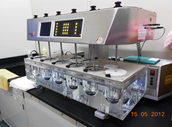Presentation
 Among the various types of materials currently known and studied, a particular category is characterized by having open pore structure. The porous material capable of retaining reversibly atomic or molecular species in the pores of nanometric dimensions and maintain its structural integrity make up a class of compounds defined as intercalation compounds.
Among the various types of materials currently known and studied, a particular category is characterized by having open pore structure. The porous material capable of retaining reversibly atomic or molecular species in the pores of nanometric dimensions and maintain its structural integrity make up a class of compounds defined as intercalation compounds.
In lamellar structures which could be interleaved, the pore size can adapt to the size of the requested species, ie, pores may be considered flexible. The attention on the layered materials is mainly due to the fact that the interaction between the host matrix and the guest can significantly alter their chemical, catalytic, electronic, optical and mechanical properties. The isolation of materials with interesting properties and through routes using mild synthesis conditions (low temperature, atmospheric pressure etc..) Has allowed the application of industrial and technological intercalation compounds as components in electrochemical devices (batteries, sensors etc.) and catalysts heterogeneous.
The research that is being developed in our laboratory has evaluated synthesis routes and proposed new methodologies for collating invited species that have catalytic activity, in order to increase the stability and reactivity of the same, as well as achieving greater selectivity in processes catalyzed . Our studies have also advanced to promote structural modifications layered materials so as to generate pores that allow the application of these materials, for example, adsorbents.
Thus, our group has prepared materials containing organic species (such as alkylammonium ions, natural dyes species of therapeutic interest, polymers such as polyaniline, benzidine, chitosan and starch) and metal complexes (such as metallated porphyrins and phthalocyanines and copper complexes with ligands diimínicos ) inserted into the pores of cationic clays, layered double hydroxides and lamellar niobates.
